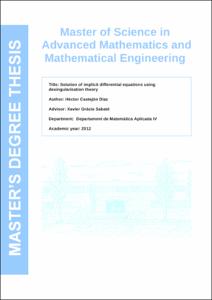Mostra el registre d'ítem simple
Solution of implicit differential equations using desingularization theory
| dc.contributor | Gràcia Sabaté, Francesc Xavier |
| dc.contributor.author | Castejón Díaz, Héctor |
| dc.contributor.other | Universitat Politècnica de Catalunya. Departament de Matemàtica Aplicada IV |
| dc.date.accessioned | 2012-09-17T14:09:12Z |
| dc.date.available | 2012-09-17T14:09:12Z |
| dc.date.issued | 2012-04 |
| dc.identifier.uri | http://hdl.handle.net/2099.1/16016 |
| dc.description.abstract | Our goal in this work is to give an algorithmic method to find solutions of a LSS. To accomplish this objective, we will give a geometric description of the problem and use some geometric tools to transform the equation and the manifold (the "ambient space") into a new set of equations, each one being an explicit ODE. When this is accomplished, one may apply Picard's theorem to these new systems to obtain the solutions. It is important to notice that (as many other theoretical results) Picard's theorem proves the existence of a solution but does not give an explicit method to nd it. Usually, in problems which require to nd explicit solutions, numerical methods are used. There also exist numerical methods for solving LSS, so one may think that (since we will use numerical methods anyway to nd the explicit solution) we could use them directly instead of wasting time implementing a method that will still depend on numerical approximations. The main point of using alternative methods for this kind of problem is (beyond the theoretical value of the algorithm) that, while numerical methods for explicit ODEs are usually accurate (in the sense that it is easy to control the error of the calculations), numerical approximations for an arbitrary LSS require (as it is explained in [RR02]) numerical inversions of quasi-singular matrices; these operations are numerically unstable. Therefore, the desingularization procedure studied here may allow to transform a numerically unstable problem into a new stable one. |
| dc.language.iso | eng |
| dc.publisher | Universitat Politècnica de Catalunya |
| dc.rights | Attribution-NonCommercial-ShareAlike 3.0 Spain |
| dc.rights.uri | http://creativecommons.org/licenses/by-nc-sa/3.0/es/ |
| dc.subject | Àrees temàtiques de la UPC::Matemàtiques i estadística::Geometria::Geometria diferencial |
| dc.subject.lcsh | Differential geometry |
| dc.title | Solution of implicit differential equations using desingularization theory |
| dc.type | Master thesis |
| dc.subject.lemac | Geometria diferencial |
| dc.subject.ams | 53 |
| dc.rights.access | Open Access |
| dc.audience.educationlevel | Màster |
| dc.audience.mediator | Universitat Politècnica de Catalunya. Facultat de Matemàtiques i Estadística |
| dc.audience.degree | MÀSTER UNIVERSITARI EN MATEMÀTICA AVANÇADA I ENGINYERIA MATEMÀTICA (Pla 2010) |



